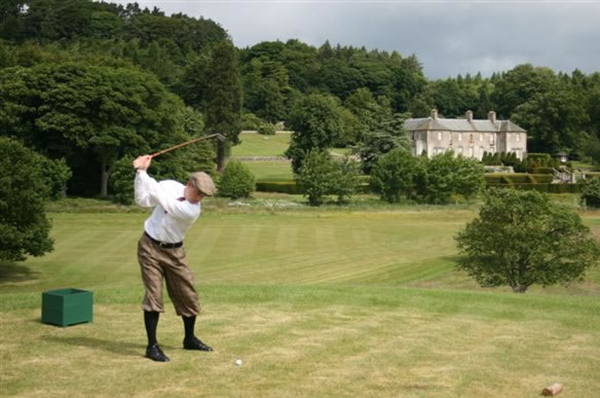Hickory Treasures introduces wonderful golf courses to play hickory golf
Panmure Golf Course – Article by Gareth Scott
Ambience
It’s a word that Andrew Crerar singled out as being Panmure at the stroke of a pen. In its typically antiseptic fashion, the Oxford Dictionary defines it as “the character and atmosphere of a place.” But in using it in answer to the ‘what makes Panmure special?’ question, Crerar, Panmure’s Director of Golf, is pointing us, not toward some vague and possibly fleeting impression of the place but, rather, towards the very real experience of being there.
“It’s a fantastic clubhouse, for example. Maybe the best in the country.”
Modelled, apparently, on the Royal Calcutta’s Maiden Pavilion, the Panmure clubhouse does much to justify such a claim. In truth, apart from the steep pitch of the roof, the ornamental bas-reliefs and the inverted pudding basin on top of the clock tower that has much in common with a pith helmet of the British Raj, the building has little to show for its supposed Indian inspiration. But the ambience? It’s most surely there. The beech panelling, the curved oak fireplaces, the rich carpeting, the memorabilia, the past Captains looking down from the walls, their lineage stretching all the way back to the Club’s founding in 1845. History with a capital H. Rich in the sense of tradition that sits at the heart of the game and equally rich in its sense of welcome.
Unlike the course perhaps, which, in the words of the current Captain, Stuart Graham, “will jump up and bite you from time to time.”
And it does.
Since he apparently started writing it on Maundy Thursday, 1300, it’s unlikely that Dante had the eighteen holes of Panmure in his mind when he began his Inferno. The topography, however, bears comparison. It was the poet Vergil who was to guide Dante on his journey through Hell and, if you ask him nicely, maybe Andrew Crerar will offer similar guidance to Panmure.
The approach to the underworld was deceptively straightforward, as are Panmure’s opening holes but the dog-leg third serves notice that your real journey is about to begin. Leaving the third, the sign might have read ‘To the fourth tee,’ rather than ‘Lasciate Ogne Speranza, Voi Ch’intrate’ but abandoning hope is always an option on making your first entrance to the Inferno that is Panmure’s famous twelve.
Beware. You are about to be bitten. An erstwhile Secretary of Panmure, one Colonel J. Lindsay Henderson, once described the wasteland that would, in time, become holes four to fifteen as “the most unpromising looking ground… consisting of large hummocks and deep ravines with marshy looking bottoms and covered with the coarsest of bent grass, whins and rushes…” A vision of Hell not unlike Dante’s first impressions of the place and, whilst the Italian writer was to escape with a mere nine circles to clamber through, ranging from Limbo and Lust to Fraud and Treachery, the Panmure golfer has all of twelve holes to survive. And please don’t be fooled. Their formidable and voracious nature is only very thinly disguised by such innocent names as Punchbowl, Dunes and, almost unbelievably, Lucky Daddy.
Indeed, the most demanding of the lot, Andrew Crerar’s signature hole, is called, quite simply, Hogan. Apparently not quite satisfied with a four hundred and fourteen yard dog-leg, an approach corridor verging on the claustrophobic and a ridged green, along with the degree of difficulty shifting with each puff of the wind, Hogan suggested that an especially greedy greenside bunker should be built, so as to swallow the unsuspecting shot to the green. And, having thus left his mark, Hogan then went on to win the 1953 Carnoustie Open. Never to be seen again.
Having travelled through the core of the Earth, Vergil and Dante finally emerged from Hell to find themselves in a very much better place, a new hemisphere and one that lay beneath star-studded skies. And, in similar vein, maybe the closing 11 12 three holes of Panmure offer their own apparent solace. Cottage, Old Road and Calcutta seem sufficiently benign titles, the prospect from the sixteenth tee made the more welcoming by the distant approach and welcome of the clubhouse. But, as ever at Panmure, beware. Appearances can be deceptive and the eighteenth has chewed up many a score card.
“You must think you way round. You mustn’t blast.”
Ignore Stuart Graham’s words at your peril. But, when you’re not doing all that thinking, give yourself room to simply stand back and enjoy the Panmure experience. The echoes of India, an almost umbilical connection honed by the centuries of the jute trade between Dundee and Calcutta.
The vision of the founders, whose unknown architect once turned a wasteland into twelve of the most fascinating holes in Scotland. The glory of a course fit for champions, many of whom still work their way across its acres in competition. And the sheer personality and welcome of the Club and its people.
History, tradition, old India and Dante’s Inferno, all rolled into one. An experience difficult to imagine and one that’s equally difficult to forget. Andrew Crerar got it right.
It’s called ambience.








Leave A Comment
You must be logged in to post a comment.